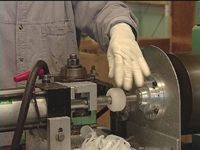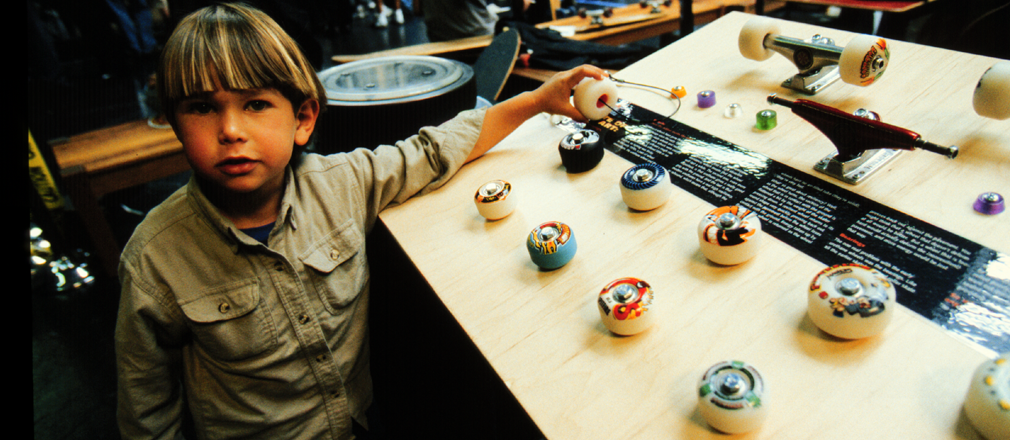Wheels: Where the Rubber Meets the Road
The Science and Art of Skateboard Design (continued...)
Skateboard wheels have gone through a dramatic change since the early 1900's when kids took roller skate wheels and nailed them to a two-by-four. Those early wheels were usually steel, which offered a rough ride, to say the least. Worse, steel wheels offered little or no traction, so riding these boards was pretty much a straight-ahead proposition. In the late 1950's, the first commercial skateboards appeared, though most boards were still homemade. By the 1960's, some advances in roller skate design led to the appearance of clay wheels. These were an improvement over metal wheels, but not by much. As one early rider described the ride, circa 1961: "It was wobblier than hell, moved way too fast, and vibrated on the asphalt enough to jar every bone in your body and loosen every tooth. It was more like getting electrocuted than anything else." (Bob Schmidt, quoted in The Concrete Wave, 1999)
But it wasn't until the early 1970's that a pair of wheel innovations would arrive that would help turn skateboarding, "from a funky, surfing activity, what you would do when the waves were down, into a real bonafide sport," according to Tim Piumarta. The urethane wheel and the press-in precision bearing changed skateboarding forever, and led to the next big explosion in skateboard popularity.
The first urethane wheels were the handiwork of Frank Nasworthy, who, after seeing some experimental urethane roller-skate wheels in a friend's backyard in 1970, realized that such wheels could be used for skateboards. Nasworthy and his friends tried them, and found that the old tooth-jarring ride was gone, replaced by a ride of unprecedented smoothness and stability. Skateboarding was in a dead period in the early 70's, but Nasworthy's wheels, called Cadillacs, began to catch on.
Fausto Vitello explained why urethane was perfect for wheels: "Urethane has some unique properties. The first is that it has really good abrasion resistance, which means that the wheel will last a while. The second one, even more important, is that urethane gives a really good grip with the ground. It will slide if you push it hard, but it gives great traction. So that means you can control your board. And the last is that modern urethanes have a real high resiliency, or rebound, which means that although the wheels have no pneumatic tube or anything (they're solid), they're still able to be very fast."

He also points out that with wheels, adding cool colors may actually weaken the wheel. "Urethane is normally a whitish clear color, when it's poured with no other agents. Dyes or pigments take up room (in the structure of the wheel) that would normally be actual urethane. Less urethane means less resiliency in the wheel. Dyes are arguably better than pigments, which really take up a lot of space. But some people argue that dyes alter the chemical structure of the urethane itself. When people are really looking for a high-performance wheel, we recommend a clear wheel."
So, as the wheel turns, the section of the wheel that is in contact with the ground is flattened a little bit by the weight of the skater pressing down. Engineers refer to this flattening as deformation. A resilient urethane wheel returns to its round shape very quickly, pressing back out against the pavement before the wheel loses contact with the ground. If the wheel rebounds more slowly, after the flattened section has rolled away from the ground, the energy that has gone into the deformation is lost, and the wheel rolls more slowly. You might think that a wheel that didn't deform at all would be better. But, as Exploratorium Physicist Paul Dougherty explained, "a wheel that is too hard would actually press on the pavement so that the pavement would deform, and more energy would be lost that way." In addition, a harder wheel loses the shock absorbing and ride-smoothening properties that were such an improvement over the early clay and metal wheels.
